IRDye® Infrared Dyes
Products

IRDye® 800CW Infrared Dyes
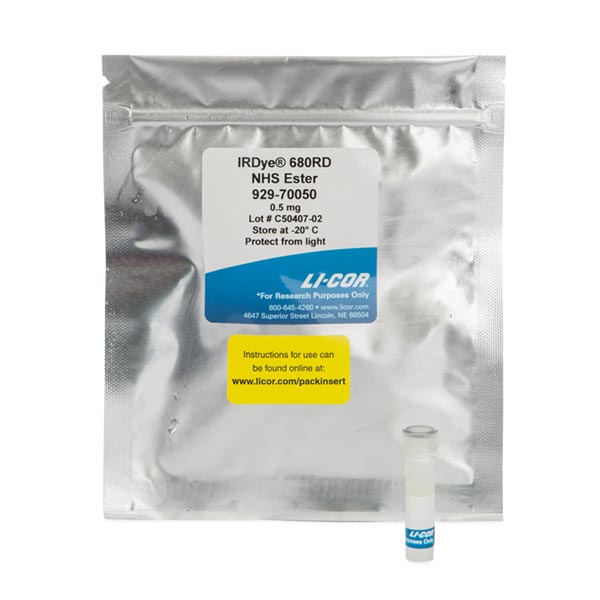
IRDye® 680RD Infrared Dyes
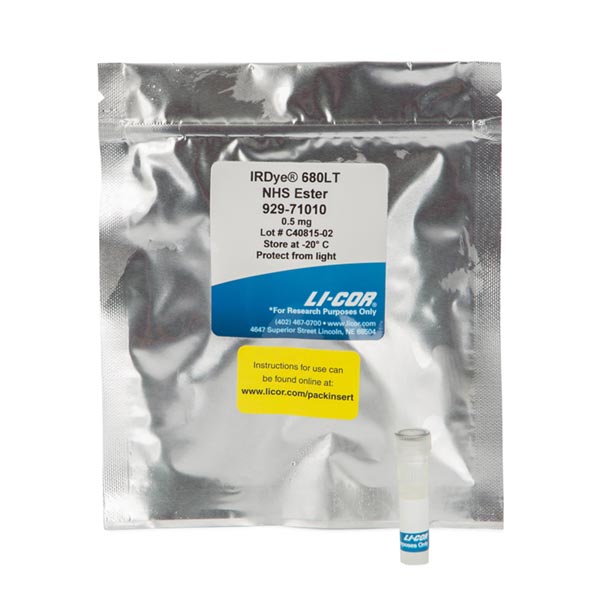
IRDye® 680LT Infrared Dyes

IRDye® 750 Infrared Dyes
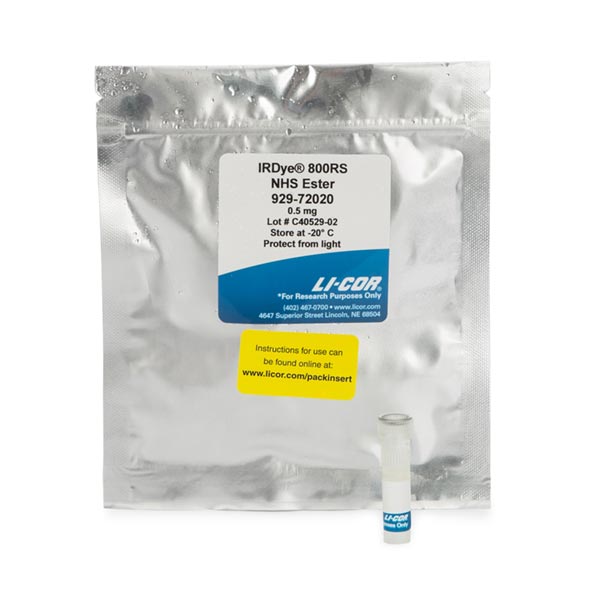
IRDye® 800RS NHS Ester
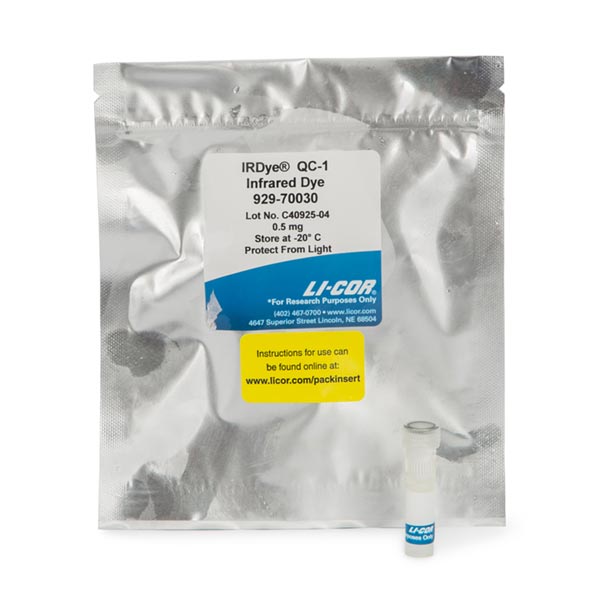
IRDye® QC-1 NHS Ester

IRDye® Phosphoramidites
IRDye Infrared Fluorescent Dyes and near-infrared (NIR) fluorescence imaging deliver enhanced sensitivity due to low background autofluorescence in the near-infrared region and, therefore, higher signal-to-noise ratios.
IRDye Fluorescent Dyes have absorption and emission wavelengths in the NIR spectrum, between 680 and 800 nm. Most of the IRDye reagents are compatible with the Odyssey® DLx, Odyssey XF, Odyssey Sa, Pearl® Imagers, and 4300 DNA Analyzer platforms.
NHS Esters
Standard NHS ester chemistry is used to produce custom probes labeled with LI-COR IRDye Infrared Dyes. The NHS ester reactive group provides the functionality for labeling primary and secondary amino groups.
Maleimides
IRDye maleimides provide the functionality for labeling molecules that contain free sulfhydryl (-SH) groups with IRDye Infrared Dyes. The reactive group of the IRDye maleimide allows conjugation reactions to be performed very efficiently at physiological pH.
Carboxylates
Assays that use infrared dye conjugates (such as in vivo imaging and cell binding assays) may require a "dye-only" control for potential effects or retention of the dye. The carboxylate dye has no reactive group and cannot be used for labeling.
Carboxylate dye forms can serve as an ideal control for cell-based assays that monitor binding of a dye-labeled agent to validate optical agents for in vivo administration and to evaluate binding specificity. This dye form can also be used to evaluate the behavior and clearance of the dye itself and as a standard to determine the amount of unreacted ("free") dye after conjugation and purification.
Labeling Kits
IRDye Protein Labeling Kits label antibodies, other proteins, and peptides for applications such as Western blots, In Cell Western™ assays, in vivo imaging, and whole organ or tissue section assays. Applications of dye-labeled conjugates vary, depending on the IRDye used for labeling.
DBCO, Alkyne, and Azide Dye Forms Used for Click Chemistry
Biomolecule labeling continues to be a cornerstone feature of many in vitro and in vivo biological experiments. Click Chemistry has recently emerged as a convenient, versatile, and reliable method for labeling a wide variety of molecules for applications ranging from biomarker isolation to assay development. Click Chemistry utilizes pairs of reagents that exclusively react with each other and are effectively inert to naturally occurring functional groups such as amines
LI-COR offers DBCO, azide, and alkyne dye forms of IRDye 800CW and IRDye 680RD.
IRDye Properties and Forms Available
| Dye | Exmax (nm)* | Emmax (nm)* | NHS Ester | Maleimide | Carboxylate | DBCO | Azide | Alkyne | Phosphoramidite | LI-COR Channel |
|---|---|---|---|---|---|---|---|---|---|---|
| IRDye 800CW | 778 | 794 | 800 nm | |||||||
| IRDye 800RS | 770 | 786 | 800 nm | |||||||
| IRDye 800 phosphoramidite | 787 | 812 | 800 nm | |||||||
| IRDye 750 | 766 | 776 | ||||||||
| IRDye 700 phosphoramidite | 680 | 697 | 700 nm | |||||||
| IRDye 680LT** | 680 | 694 | 700 nm | |||||||
| IRDye 680RD | 680 | 694 | 700 nm |
* Data collected using methanol as the solvent.
** IRDye 680LT dye products should not be used for small animal in vivo imaging or In-Cell Western Assays. The higher level of fluorescent intensity creates high background making it unfavorable for use in these applications. We recommend using IRDye 680RD dye products for these applications.
Which 700 Channel Dye Should I Use?
LI-COR offers three distinct 700 channel dyes for a variety of applications. Choosing the correct dye is critical when developing an experiment. A summary of each dye and an application table are provided to help you determine which dye is best for your needs.
IRDye 680RD
IRDye 680RD is the near-infrared fluorescent dye of choice for small animal imaging, Western blot, and In-Cell Western Assay applications in the 700nm channel. It has the lowest background compared to LI-COR's other 700 nm dyes and can be used for the widest variety of applications with little optimization. The NHS ester and maleimide forms of this infrared dye are ideal for labeling proteins, peptides, and antibodies. LI-COR offers a variety of IRDye 680RD dyes, labeling kits and secondary antibodies.
IRDye 680LT
IRDye 680LT is significantly brighter and more photostable than many other 700 nm near-infrared dyes such as Alexa Fluor® 680. It provides superior performance for protein detection applications, including microscopy and Western blot applications. LI-COR offers a variety of IRDye 680LT dyes, labeling kits, and secondary antibodies. When using IRDye 680LT secondary antibodies for Western blot detection, it is critical to follow the recommendations in the pack insert. Dilution optimization may be required to achieve best results.
| Application | IRDye 680RD | IRDye 680LT |
|---|---|---|
| Western Blot | ||
| In-Cell Western Assay | not recommended | |
| On-Cell Western Assay | not recommended | |
| RNAi Screens | for Western blots only | |
| Protein Array | ||
| Immunohistochemistry | ||
| Microscopy | ||
| 2D Gel Detection | ||
| Tissue Section Imaging | ||
| FRET-based Assays | ||
| Small Animal Imaging | not recommended |
IRDye Infrared Dyes are Optimized for Near-Infrared Fluorescent Detection
IRDye Near-Infrared Dyes are optimized for excitation and detection in the near-infrared spectrum, providing numerous benefits.
- Low background autofluorescence allows higher signal to noise ratios (see Figure 1)
- Wide range of dyes and functional groups available for multiple applications
- Excellent photostability
- Dye brightness
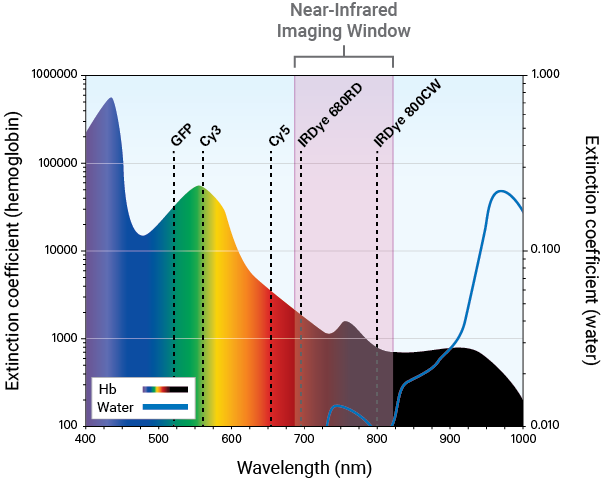
IRDye 800CW Infrared Dye Successfully Completes Toxicity Studies
LI-COR offers IRDye 800CW that has been manufactured under current good manufacturing practices (cGMP) and is available for conjugation to targeted biomolecules for investigational use in clinical trials. In September of 2007, LI-COR Biosciences announced the successful completion of animal toxicity studies of its IRDye 800CW infrared dye carboxylic acid using a protocol reviewed by the Food and Drug Administration. The completion of the toxicity studies was a key milestone in the development of the IRDye 800CW dye for potential clinical imaging use. The complete report was published in 2010 and is available to the public. In addition, drug master files (DMF) are on record with U.S. and European regulatory authorities.
LI-COR IRDye Infrared Fluorescent Dyes are used for protein and cellular assays, microscopy, and in vivo molecular imaging in animals for research purposes. IRDye 800CW is cited in a wide variety of published non-clinical research for labeling nucleic acids, antibodies, proteins, and peptides where there is a need for high signal, low background imaging. With an 800nm emission wavelength, the IRDye 800CW dye is spectrally ideal for animal imaging research.
While the IRDye 800CW dye has successfully completed toxicity studies, it has not been studied for diagnostic or therapeutic use in humans, and has not been approved by the Food and Drug Administration for this use. LI-COR is exploring options for additional studies as next steps in the Food and Drug Administration approval process leading toward clinical use.